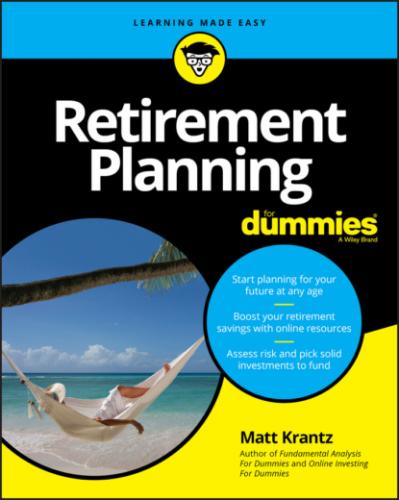In addition, some people get so discouraged about being off track with their retirement planning that they just give up. They figure they’ll never catch up to where they think they need to be. Cautionary tales of people who have not saved enough only make people more depressed. You can find lots of those stories. Maybe people you know shared their stories with you.
Put the fear and discouragement aside for a minute. This retirement-planning book is different. I want you to embrace, not dread, retirement planning. What better way to plan for the future than picturing what you want it to look like and then making it happen? Expectations must match reality, but you might be amazed at what you can do when you set your mind to a goal.
Retirement planning is an important way to plot your financial course. And the course you set by reading this book will help make sure that your life 20, 30, 40, or 50 years from now is what you think it should be.
In this chapter, you find out why retirement planning is largely an opportunity for you to plan your own future, rather than have it dictated to you by your employer or government. You also see why getting your plan started as soon as possible pays off in a big way.
Blazing Your Own Retirement Plan
Retirement planning is simply about making sure you have resources available when you’re no longer generating them from your labor. However, the financial industry hijacked retirement planning, and now it’s all about deferred tax accounts, 401(k)s, and mutual funds. It wasn’t always that way.
More than a hundred years ago, more Americans relied on direct labor for their basic needs. In the late 1800s, for instance, about half of Americans were involved in farming. Back then, retirement planning was “an heir and a spare.” You wanted to make sure that you had enough kids to keep the farm running after you no longer wanted, or were able, to push a plow.
But now, less than 5 percent of the population touches food before it arrives at the grocery store. And people are more mobile, so your adult children are just as likely to live on the other side of the state as in your basement. In addition, birthrates are falling as more people decide against having children.
These shifts have turned money into the currency of retirement planning. Rather than having a house full of children who will take care of you in your grand old age, retirement planning is about having enough money when you can no longer work. Famous investor Warren Buffett addressed the importance of putting your money to work when he said, “If you don’t find a way to make money while you sleep, you will work until you die.”
Measuring Your Lifespan
Adding to the planning complexity is the fact that Americans are living much longer than they used to, as shown in Table 1-1. That news is great for humans, but it also means retirement planning for most people must stretch an additional 10 years or longer.
TABLE 1-1 Life Expectancy of Americans
| Year You Were Born | Life Expectancy (Both Sexes Combined) |
| 1955–1960 | 69.66 |
| 1960– 1965 | 70.11 |
| 1965– 1970 | 70.36 |
| 1970– 1975 | 71.43 |
| 1975– 1980 | 73.25 |
| 1980– 1985 | 74.37 |
| 1985– 1990 | 75.89 |
| 1990– 1995 | 75.65 |
| 1995– 2000 | 76.47 |
| 2000– 2005 | 77.18 |
| 2005– 2010 | 78.19 |
| 2010– 2015 | 78.94 |
| 2015– 2020 | 78.81 |
United Nations, Department of Economic and Social Affairs, Population Division (2019). World Population Prospects: The 2019 Revision; custom data acquired via website.
https://population.un.org/wpp/DataQuery/.
Time to take a break from the history of retirement planning to answer the question you’re probably asking now that you’ve read this far: How long will you live? I am not getting fatalistic. Knowing how long you can expect to live is a big part of retirement planning. After all, a person who expects to live to 90 will save and work differently than someone likely to die younger.
I cover this topic in more detail later, but now’s as good a time as any to think about your lifespan a bit. I keep the discussion optimistic by focusing on how long you’ll live (versus when you’ll die). In this section I provide my favorite tools to help you make this calculation.
Social Security Administration’s Life Expectancy Calculator
The U.S. government has a good idea about how long you’ll live. After all, as the largest payer of income to older people, it’s in the government’s best interest to know this information.
The Social Security Administration’s Life Expectancy Calculator at www.ssa.gov/OACT/population/longevity.html looks at your gender and date of birth to estimate how long you'll live.
For example if you're a 40-year-old male in 2019, you would see a table like the one in Figure 1-1 after entering your gender and date of birth. You would be expected to live until 81.7, which means at 40 you'd be just about ready for a mid-life crisis. If you were healthy enough to make it to 67, the Social Security Administration would figure that you would make it to 86.
Bankrate’s Life Expectancy Calculator
You probably know that not all 40-year-olds will live exactly 81.7 years. Some lifestyle choices, such as smoking, have a bearing on how long you live. (Let’s forget about George Burns, the chain-smoking comedian who lived until 100.)
Bankrate tries to capture that variability in its Life Expectancy Calculator at www.bankrate.com/calculators/retirement/life-age-expectancy-calculator.aspx.
